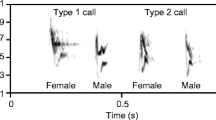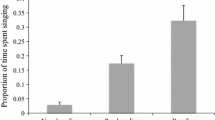Abstract
Seasonal patterns of bird song have been studied intensively with a focus on individual males. However, little is known about seasonal patterns of singing during vocal interactions between males. Vocal interactions have been shown to be important in sexual selection as males may signal aspects of motivation or quality. Here, we investigated in nightingales (Luscinia megarhynchos) whether a male’s behaviour in vocal interactions at different stages of the breeding season is influenced by its mating status. We examined how males that differ in their subsequent mating success respond to a non-interactive, nocturnal playback presented during the period of mate attraction and subsequently during the egg-laying period. We found that mated males overlapped fewer songs and had a lower song rate during the egg-laying period compared to their responses during the mate-attraction period, whereas unpaired males did not vary in their responses between the two periods. Our results suggest that mating status is a key factor affecting singing behaviour in vocal interactions and that a time-specific singing pattern like song overlapping is used flexibly during vocal interactions. Because song overlapping is thought to be a signal of aggression in male–male vocal interactions, it seems that males vary the level of aggression in vocal interactions according to their mating status and to the stage in the breeding season.


Similar content being viewed by others
References
Amrhein V, Korner P, Naguib M (2002) Nocturnal and diurnal singing activity in the nightingale: correlations with mating status and breeding cycle. Anim Behav 64:939–944
Amrhein V, Kunc HP, Naguib M (2004a) Seasonal patterns of singing activity vary with time of day in the nightingale (Luscinia megarhynchos). Auk 121:110–117
Amrhein V, Kunc HP, Naguib M (2004b) Non-territorial nightingales prospect territories during the dawn chorus. Proc R Soc Lond B 271:S167–S169 (Suppl)
Birkhead TR, Møller AP (1992) Sperm competition in birds: evolutionary causes and consequences. Academic, London
Brindley EL (1991) Response of European robins to playback of song: neighbour recognition and overlapping. Anim Behav 41:503–512
Brumm H (2004) The impact of environmental noise on song amplitude in a territorial bird. J Anim Ecol 73:434–440
Dabelsteen T (1992) Interactive playback: a finely tuned response. In: McGregor PK (ed) Playback and studies of animal communication. Plenum, New York, pp 97–109
Dabelsteen T, McGregor PK, Holland J, Tobias JA, Pedersen SB (1997) The signal function of overlapping singing in male robins. Anim Behav 53:249–256
Forstmeier W, Balsby TJS (2002) Why mated dusky warblers sing so much: territory guarding and male quality announcement. Behaviour 139:89–111
Gil D, Graves JA, Slater PJ (1999) Seasonal patterns of singing in the willow warbler: evidence against the fertility announcement hypothesis. Anim Behav 58:995–1000
Hall ML, Illes A, Vehrencamp SL (2006) Overlapping signals in banded wrens: long-term effects of prior experience on males and females. Behav Ecol 17:260–269
Hultsch H, Todt D (1981) Repertoire sharing and song-post distance in nightingales (Luscinia megarhynchos). Behav Ecol Sociobiol 8:183–188
Hultsch H, Todt D (1982) Temporal performance roles during vocal interactions in nightingales (Luscinia megarhynchos). Behav Ecol Sociobiol 11:253–260
Hultsch H, Todt D (1996) Rules of parameter variation in homotype series of birdsong can indicate a “sollwert” significance. Behav Processes 38:175–182
Hyman J, Hughes M, Searcy WA, Nowicki S (2004) Individual variation in the strength of territory defense in male song sparrows: correlations of age, territory tenure, and neighbor aggressiveness. Behaviour 141:15–27
Kipper S, Mundry R, Hultsch H, Todt D (2004) Long-term persistence of song performance rules in nightingales (Luscinia megarhynchos): a longitudinal field study on repertoire size and composition. Behaviour 141:371–390
Kunc HP, Amrhein V, Naguib M (2005a) Acoustic features of song categories and their possible implications for communication in the common nightingale (Luscinia megarhynchos). Behaviour 142:1083–1097
Kunc HP, Amrhein V, Naguib M (2005b) Seasonal variation of dawn song characteristics in the common nightingale. Anim Behav 70:1265–1271
Kunc HP, Amrhein V, Naguib M (2006) Vocal interactions in common nightingales: more aggressive males have higher pairing success. Anim Behav 72:25–30
Langemann U, Tavares JP, Peake TM, McGregor PK (2000) Response of great tits to escalating patterns of playback. Behaviour 137:451–471
Leboucher G, Pallot K (2004) Is he all he says he is? Intersexual eavesdropping in the domestic canary, Serinus canaria. Anim Behav 68:957–963
Leitner S, Voigt C, Gahr M (2001) Seasonal changes in the song pattern of the non-domesticated island canary (Serinus canaria), a field study. Behaviour 138:885–904
Liu W-C (2004) The effect of neighbours and females on dawn and daytime singing behaviours male chipping sparrows. Anim Behav 68:39–44
McGregor PK, Dabelsteen T (1996) Communication networks. In: Kroodsma DE, Miller EH (eds) Ecology and evolution of acoustic communication in birds. Cornell University Press, Ithaca, NY, pp 409–425
McGregor PK, Peake TM (2000) Communication networks: social environments for receiving and signalling behaviour. Acta Ethol 2:71–81
Mennill DJ, Ratcliffe LM (2004) Overlapping and matching in the song contests of black-capped chickadees. Anim Behav 67:441–450
Mennill DJ, Ratcliffe LM, Boag PT (2002) Female eavesdropping on male song contests in songbirds. Science 296:873
Mennill DJ, Boag PT, Ratcliffe LM (2003) The reproductive choices of eavesdropping female black-capped chickadees, Poecile atricapillus. Naturwissenschaften 90:577–582
Miyazaki M, Waas JR (2002) “Last word” effects of male advertising calls on female preference in little blue penguins. Behaviour 139:1413–1423
Møller AP (1991) Why mated songbirds sing so much: mate guarding and male announcement of mate fertility status. Am Nat 138:994–1013
Naguib M (2005) Singing interactions in song birds: implications for social relations, territoriality and territorial settlement. In: McGregor PK (ed) Animal communication networks. Cambridge University Press, Cambridge, pp 300–319
Naguib M (1999) Effects of song overlapping and alternating on nocturnally singing nightingales. Anim Behav 58:1061–1067
Naguib M, Todt D (1997) Effects of dyadic vocal interactions on other conspecific receivers in nightingales. Anim Behav 54:1535–1543
Naguib M, Amrhein V, Kunc HP (2004) Effects of territorial intrusions on eavesdropping neighbors: communication networks in nightingales. Behav Ecol 6:1011–1015
Nowicki S, Searcy WA, Krueger T, Hughes M (2002) Individual variation in response to simulated territorial challenge among territory-holding song sparrows. J Avian Biol 33:253–259
Oliveira RF, McGregor PK, Latruffe C (1998) Know thine enemy: fighting fish gather information from observing conspecific interactions. Proc R Soc Lond Ser B Biol Sci 265:1045–1049
Osiejuk TS, Ratynska K, Cygan JP (2004) Signal value of alternating and overlapping singing in the Yellowhammer Emberiza citrinella. J Ethol 22:55–61
Otter K, McGregor PK, Terry AMR, Burford FRL, Peake TM, Dabelsteen T (1999) Do female great tits (Parus major) assess males by eavesdropping? A field study using interactive song playback. Proc R Soc Lond Ser B Biol Sci 266:1305–1309
Peake TM, Terry AMR, McGregor PK, Dabelsteen T (2001) Male great tits eavesdrop on simulated male-to-male vocal interactions. Proc R Soc Lond Ser B Biol Sci 268:1183–1187
Peake TM, Terry AMR, McGregor PK, Dabelsteen T (2002) Do great tits assess rivals by combining direct experience with information gathered by eavesdropping? Proc R Soc Lond Ser B Biol Sci 269:1925–1929
Pinxten R, Eens M (1998) Male starlings sing most in the late morning, following egg-laying: a strategy to protect their paternity? Behaviour 135:1197–1211
Schmidt R, Amrhein V, Kunc HP, Naguib M (2006) The day after: Effects of vocal interactions on territory defence in nightingales. J Anim Ecol (in press)
Sheldon BC (2000) Differential allocation: tests, mechanisms and implications. Trends Ecol Evol 15:397–402
Staicer CA, Spector DA, Horn AG (1996) The dawn chorus and other diel patterns in acoustic signaling. In: Kroodsma DE, Miller EH (eds) Ecology and evolution of acoustic communication in birds. Cornell University Press, London, pp 426–453
Todt D, Naguib M (2000) Vocal interactions in birds: the use of song as a model in communication. Adv Study Behav 29:247–296
Vehrencamp SL (2000) Handicap, index, and conventional signal elements of bird song. In: Espmark Y, Amundsen T, Rosenqvist G (ed) Animals signals: signal design in animal communication. Tapir, Trondheim, pp 227–300
Acknowledgments
We thank Helene Altrichter, Cas Eikenaar, Christopher Herhausen, Gerd Kraus, Stephanie Michler, Rouven Schmidt, Anne Selbach, Balázs Szelényi and Marieke Weerheim for assistance in the field. Joah Madden, Angelika Poesel, Rouven Schmidt, Jeff Podos and anonymous referees gave valuable comments on the manuscript. Permission for ringing was kindly granted by Henri Jenn and by the Centre de Recherches sur la Biologie des Populations d’Oiseaux, Paris, France. The research was made possible by the Swiss Association Pro Petite Camargue Alsacienne, the Swiss Foundation Emilia Guggenheim-Schnurr and the Deutsche Forschungsgemeinschaft (Na 335/4-1, 4-2).
Author information
Authors and Affiliations
Corresponding author
Additional information
Communicated by J. Podos
Rights and permissions
About this article
Cite this article
Kunc, H.P., Amrhein, V. & Naguib, M. Vocal interactions in common nightingales (Luscinia megarhynchos): males take it easy after pairing. Behav Ecol Sociobiol 61, 557–563 (2007). https://doi.org/10.1007/s00265-006-0284-z
Received:
Revised:
Accepted:
Published:
Issue Date:
DOI: https://doi.org/10.1007/s00265-006-0284-z




